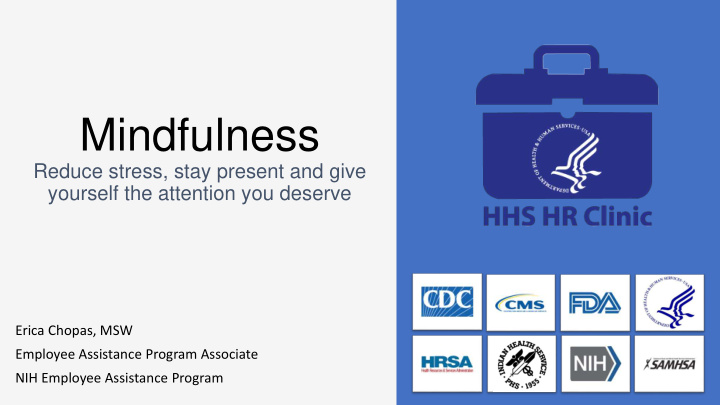



Mindfulness Reduce stress, stay present and give yourself the attention you deserve Erica Chopas, MSW Employee Assistance Program Associate NIH Employee Assistance Program
The Role of NIH EAP NIH EAP is a free, voluntary and confidential program that helps employees (including managers) work through various challenges that may adversely affect job performance, health, or personal well-being to optimize NIH’s success. 2
Quick Glance: NIH EAP Services 3
NIH EAP Works: Workplace Outcome Suite Jan.' 12 - Jan. '18 EAP Pre and Post Intervention Results 16% Improvement Pre Post 4 3.76 3.5 26% Improvement 3.23 3.10 18% Improvement 3 2.66 2.5 2.28 2.17 2 1.5 1 0.5 0 PRESENTEEISM LIFE SATISFACTION WORKPLACE DISTRESS Statistically significant favorable outcomes for all areas measured with N=640 * 4
EAP Contact Information • By phone: 301-496-3164 • On the web: www.ors.od.nih.gov/sr/dohs/eap • In person: NIH Main Campus, Building 31, Room B2B57 • Serving NIH facilities in the following locations: Bethesda, MD Baltimore, MD Rockville, MD Frederick, MD Gaithersburg, MD Hamilton, MT Durham, NC 5
Objectives • Introduction to mindfulness • Mindfulness in the workplace • Activity • Incorporating mindfulness into each day • Conclusion/Questions 6
What is Mindfulness? “Mindfulness is the basic human ability to be fully present, aware of where we are and what we’re doing, and not overly reactive or overwhelmed by what’s going on around us” Mindful.org 7
Characteristics of Mindfulness • Being fully present • Awareness • Openness to experience • Non-judgement of thoughts and feelings • Acceptance • Connection • Peace • Compassion for oneself 8
How can mindfulness be beneficial? • Increased productivity • Gives clarity to solve problems • Builds patience • Increased self-awareness • Improves memory • Increased focus 9
Mindfulness Myths 1. Mindfulness takes a long time and is only accomplished through meditation 2. Mindfulness means staying present 24/7 3. Mindfulness requires you to shut off your mind 4. Mindfulness = automatic happiness 5. Mindfulness means taking a passive approach 10
Mindfulness at Work 11
Mindfulness at Work Continued • Give your full attentions to tasks • Commit to single-tasking • Turn off unhelpful distractions • Set up reminders to practice mindfulness • Change your perception of stress • Practice gratitude • Practice acceptance 12
Mindfulness – Let’s Try It Raisin Activity 13
Everyday Mindfulness Waking up • Take three long breaths in through your nose and out through your mouth • Notice your body as you breathe • Set intention for the day - What do you feel is important? • Ex. Being kind to yourself, remaining patient, having fun 14
Everyday Mindfulness Eating • When eating lunch, turn away from your computer • Notice the smell, texture, tastes and colors of your food 15
Everyday Mindfulness Working Out • Breathe deeply and allow your focus to shift from life’s distractions to feelings of being strong and able • Challenge yourself and notice how you feel when your body is pushed • Do you feel more alert? More capable? What is your body doing that is helping you complete this exercise? 16
Conclusion • Mindfulness is readily available tool • Make it work for you – what suggestions have sounded the most comfortable or realistic for your day to day life? • Use Mindfulness apps to get you started • Calm, Buddhify, Stop Breathe & Think • Remember, it takes practice! 17
Alidina, S. (2016). 10 ways to be more mindful at work. Retrieved from https: / / www.mindful.org/ 10- ways-mindful-work/ References Ellard, J. (2017). 5 common workplace obstacles that impact well-being. Retrieved from https: / / www.mindful.org/ running-on-empty/ Goleman, D. (2017). Here's what mindfulness is (and isn't) good for. Retrieved from https: / / www.mindful.org/ heres-mindfulness-isnt-good/ Jones, C. (2016). 6 myths about mindfulness we all need to stop believing. Retrieved from https: / / www.huffingtonpost.com/ cheryl-jones/ myths-about-mindfulness-to-stop- believing_b_8958372.html Stahl, B., Goldstein, E., Santorelli, S., & Kabat-Zinn, J. (2010). A mindfulness-based stress reduction workbook . Oakland, CA: New Harbinger Publications.
Recommend
More recommend